高级英语修辞手法Oxymoron
- 格式:ppt
- 大小:173.50 KB
- 文档页数:2
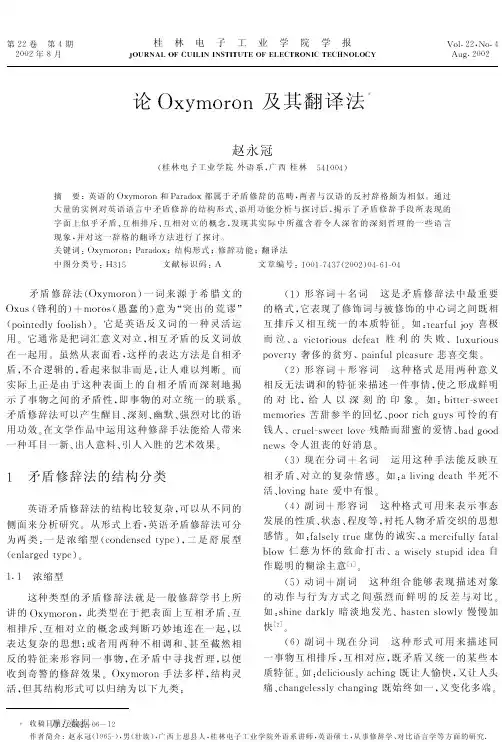
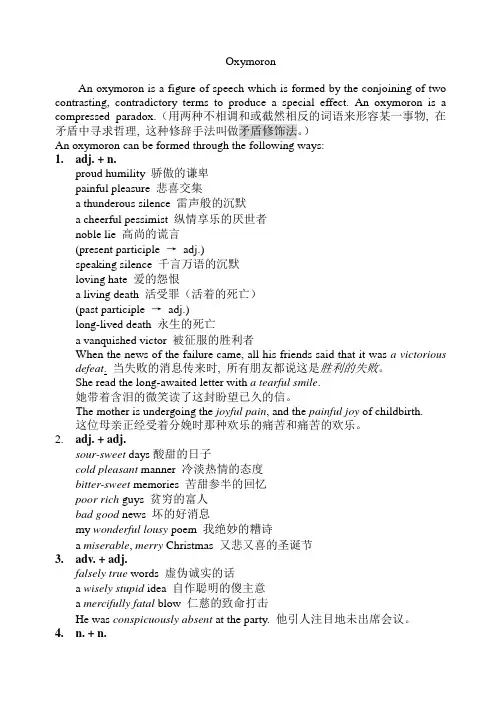
OxymoronAn oxymoron is a figure of speech which is formed by the conjoining of two contrasting, contradictory terms to produce a special effect. An oxymoron is a compressed paradox.(用两种不相调和或截然相反的词语来形容某一事物, 在矛盾中寻求哲理, 这种修辞手法叫做矛盾修饰法。
)An oxymoron can be formed through the following ways:1.adj. + n.proud humility 骄傲的谦卑painful pleasure 悲喜交集a thunderous silence 雷声般的沉默a cheerful pessimist 纵情享乐的厌世者noble lie 高尚的谎言(present participle →adj.)speaking silence 千言万语的沉默loving hate 爱的怨恨a living death 活受罪(活着的死亡)(past participle →adj.)long-lived death 永生的死亡a vanquished victor 被征服的胜利者When the news of the failure came, all his friends said that it was a victorious defeat. 当失败的消息传来时, 所有朋友都说这是胜利的失败。
She read the long-awaited letter with a tearful smile.她带着含泪的微笑读了这封盼望已久的信。
The mother is undergoing the joyful pain, and the painful joy of childbirth.这位母亲正经受着分娩时那种欢乐的痛苦和痛苦的欢乐。
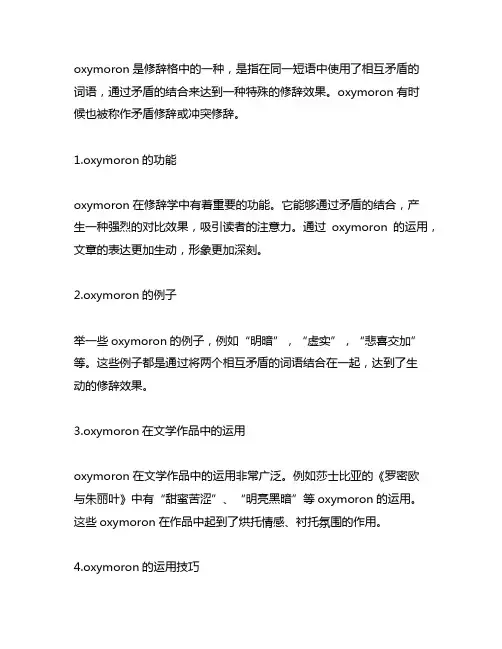
oxymoron是修辞格中的一种,是指在同一短语中使用了相互矛盾的词语,通过矛盾的结合来达到一种特殊的修辞效果。
oxymoron有时候也被称作矛盾修辞或冲突修辞。
1.oxymoron的功能oxymoron在修辞学中有着重要的功能。
它能够通过矛盾的结合,产生一种强烈的对比效果,吸引读者的注意力。
通过oxymoron的运用,文章的表达更加生动,形象更加深刻。
2.oxymoron的例子举一些oxymoron的例子,例如“明暗”,“虚实”,“悲喜交加”等。
这些例子都是通过将两个相互矛盾的词语结合在一起,达到了生动的修辞效果。
3.oxymoron在文学作品中的运用oxymoron在文学作品中的运用非常广泛。
例如莎士比亚的《罗密欧与朱丽叶》中有“甜蜜苦涩”、“明亮黑暗”等oxymoron的运用。
这些oxymoron在作品中起到了烘托情感、衬托氛围的作用。
4.oxymoron的运用技巧在运用oxymoron时,需要注意合理搭配词语,避免过于牵强的搭配。
同时还需要考虑上下文的语境,确保oxymoron的运用能够与整个语境相契合,使得修辞效果更加突出。
5.oxymoron的运用场景oxymoron的运用并非局限在文学作品中,实际上在日常生活和商业宣传中也能看到它的身影。
例如一些广告词中常常出现“冰火两重天”、“充满孤独的狂欢”等oxymoron的用法,起到了吸引人们注意的效果。
6.总结oxymoron作为一种修辞手法,在文学作品中有着重要的地位。
通过合理运用oxymoron,可以帮助作品更加生动形象,同时也能够吸引读者的注意力,增强作品的表现力和感染力。
然而,在运用oxymoron时也需要慎重,确保其与整体语境相契合,才能体现出其修辞的艺术价值。
7. oxymoron的文学价值oxymoron在文学创作中被广泛运用,并且在不同的文学体裁和风格中都能发挥其独特的作用。
在诗歌中,oxymoron可以帮助诗人突出诗歌的表现力和感染力。
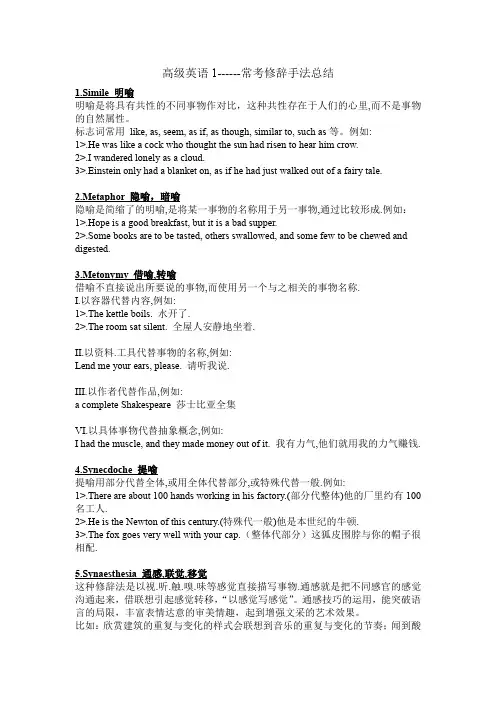
高级英语1------常考修辞手法总结1.Simile 明喻明喻是将具有共性的不同事物作对比,这种共性存在于人们的心里,而不是事物的自然属性。
标志词常用like, as, seem, as if, as though, similar to, such as等。
例如:1>.He was like a cock who thought the sun had risen to hear him crow.2>.I wandered lonely as a cloud.3>.Einstein only had a blanket on, as if he had just walked out of a fairy tale.2.Metaphor 隐喻,暗喻隐喻是简缩了的明喻,是将某一事物的名称用于另一事物,通过比较形成.例如:1>.Hope is a good breakfast, but it is a bad supper.2>.Some books are to be tasted, others swallowed, and some few to be chewed and digested.3.Metonymy 借喻,转喻借喻不直接说出所要说的事物,而使用另一个与之相关的事物名称.I.以容器代替内容,例如:1>.The kettle boils. 水开了.2>.The room sat silent. 全屋人安静地坐着.II.以资料.工具代替事物的名称,例如:Lend me your ears, please. 请听我说.III.以作者代替作品,例如:a complete Shakespeare 莎士比亚全集VI.以具体事物代替抽象概念,例如:I had the muscle, and they made money out of it. 我有力气,他们就用我的力气赚钱.4.Synecdoche 提喻提喻用部分代替全体,或用全体代替部分,或特殊代替一般.例如:1>.There are about 100 hands working in his factory.(部分代整体)他的厂里约有100名工人.2>.He is the Newton of this century.(特殊代一般)他是本世纪的牛顿.3>.The fox goes very well with your cap.(整体代部分)这狐皮围脖与你的帽子很相配.5.Synaesthesia 通感,联觉,移觉这种修辞法是以视.听.触.嗅.味等感觉直接描写事物.通感就是把不同感官的感觉沟通起来,借联想引起感觉转移,“以感觉写感觉”。
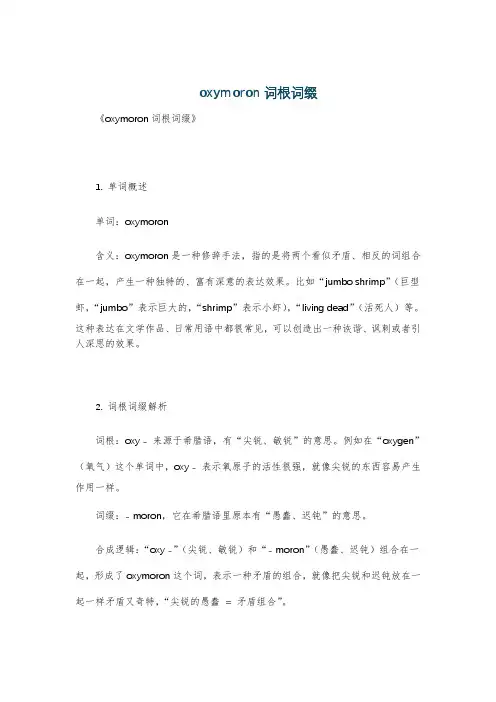
oxymoron词根词缀《oxymoron词根词缀》1. 单词概述单词:oxymoron含义:oxymoron是一种修辞手法,指的是将两个看似矛盾、相反的词组合在一起,产生一种独特的、富有深意的表达效果。
比如“jumbo shrimp”(巨型虾,“jumbo”表示巨大的,“shrimp”表示小虾),“living dead”(活死人)等。
这种表达在文学作品、日常用语中都很常见,可以创造出一种诙谐、讽刺或者引人深思的效果。
2. 词根词缀解析词根:oxy - 来源于希腊语,有“尖锐、敏锐”的意思。
例如在“oxygen”(氧气)这个单词中,oxy - 表示氧原子的活性很强,就像尖锐的东西容易产生作用一样。
词缀:- moron,它在希腊语里原本有“愚蠢、迟钝”的意思。
合成逻辑:“oxy -”(尖锐、敏锐)和“- moron”(愚蠢、迟钝)组合在一起,形成了oxymoron这个词,表示一种矛盾的组合,就像把尖锐和迟钝放在一起一样矛盾又奇特,“尖锐的愚蠢= 矛盾组合”。
3. 应用短文与场景应用短文1:English:I was reading a book the other day, and I came across this really interesting oxymoron - "bittersweet". It got me thinking about how life is full of these oxymoronic situations. I was chatting with my friend Tom about it. "Tom," I said, "isn't it crazy how we have words like 'bittersweet'? It's like saying something is both good and bad at the same time." Tom laughed and replied, "Yeah, it's like that time I got a promotion at work but had to move to a new city away from all my friends. It was a happy - sad moment, just like 'bittersweet'." We started coming up with more examples. "What about 'deafening silence'?" I asked. "Oh, that's a great one!" Tom exclaimed. "It's like when you're in a big empty room, and there's no sound at all, but the lack of noise is almost overwhelming. It's as if the silence is so loud it deafens you." This made me realize how oxymorons can really capture the complexity of our feelings and experiences.Chinese translation:前几天我在看书的时候,碰到了一个非常有趣的矛盾修饰法的词——“苦乐参半”。
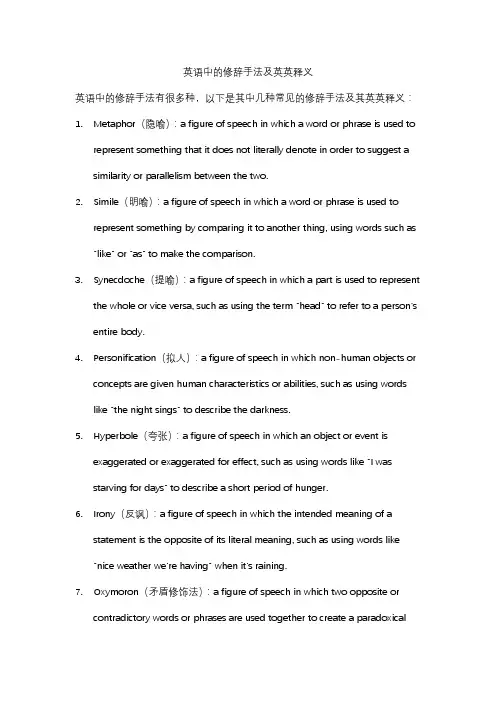
英语中的修辞手法及英英释义英语中的修辞手法有很多种,以下是其中几种常见的修辞手法及其英英释义:1.Metaphor(隐喻):a figure of speech in which a word or phrase is used torepresent something that it does not literally denote in order to suggest a similarity or parallelism between the two.2.Simile(明喻):a figure of speech in which a word or phrase is used torepresent something by comparing it to another thing, using words such as "like" or "as" to make the comparison.3.Synecdoche(提喻):a figure of speech in which a part is used to representthe whole or vice versa, such as using the term "head" to refer to a person's entire body.4.Personification(拟人):a figure of speech in which non-human objects orconcepts are given human characteristics or abilities, such as using words like "the night sings" to describe the darkness.5.Hyperbole(夸张):a figure of speech in which an object or event isexaggerated or exaggerated for effect, such as using words like "I wasstarving for days" to describe a short period of hunger.6.Irony(反讽):a figure of speech in which the intended meaning of astatement is the opposite of its literal meaning, such as using words like"nice weather we're having" when it's raining.7.Oxymoron(矛盾修饰法):a figure of speech in which two opposite orcontradictory words or phrases are used together to create a paradoxicaleffect, such as using words like "bittersweet" to describe a mixed feeling of happiness and sadness.这些修辞手法都可以增强语言的表达力,帮助传达更深刻的意义。
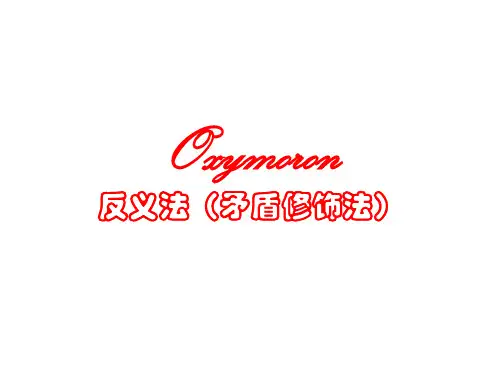
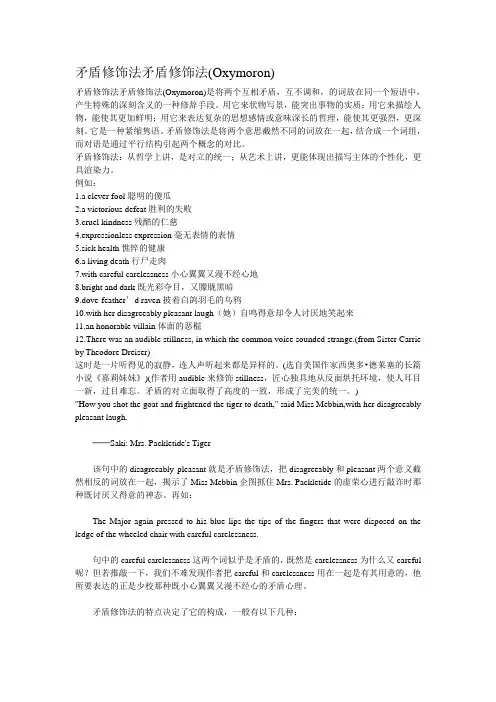
矛盾修饰法矛盾修饰法(Oxymoron)矛盾修饰法矛盾修饰法(Oxymoron)是将两个互相矛盾,互不调和,的词放在同一个短语中,产生特殊的深刻含义的一种修辞手段。
用它来状物写景,能突出事物的实质;用它来描绘人物,能使其更加鲜明;用它来表达复杂的思想感情或意味深长的哲理,能使其更强烈,更深刻。
它是一种紧缩隽语。
矛盾修饰法是将两个意思截然不同的词放在一起,结合成一个词组,而对语是通过平行结构引起两个概念的对比。
矛盾修饰法:从哲学上讲,是对立的统一;从艺术上讲,更能体现出描写主体的个性化,更具渲染力。
例如:1.a clever fool聪明的傻瓜2.a victorious defeat胜利的失败3.cruel kindness残酷的仁慈4.expressionless expression毫无表情的表情5.sick health憔悴的健康6.a living death行尸走肉7.with careful carelessness小心翼翼又漫不经心地8.bright and dark既光彩夺目,又朦胧黑暗9.dove-feather’d raven披着白鸽羽毛的乌鸦10.with her disagreeably pleasant laugh(她)自鸣得意却令人讨厌地笑起来11.an honorable villain体面的恶棍12.There was an audible stillness, in which the common voice sounded strange.(from Sister Carrie by Theodore Dreiser)这时是一片听得见的寂静,连人声听起来都是异样的。
(选自美国作家西奥多•德莱塞的长篇小说《嘉莉妹妹》)(作者用audible来修饰stillness,匠心独具地从反面烘托环境,使人耳目一新,过目难忘。
矛盾的对立面取得了高度的一致,形成了完美的统一。
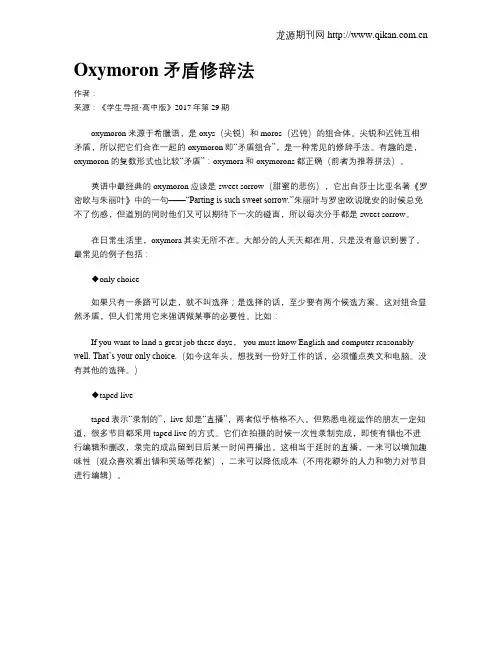
龙源期刊网 Oxymoron矛盾修辞法作者:来源:《学生导报·高中版》2017年第29期oxymoron来源于希臘语,是oxys(尖锐)和moros(迟钝)的组合体。
尖锐和迟钝互相矛盾,所以把它们合在一起的oxymoron即“矛盾组合”,是一种常见的修辞手法。
有趣的是,oxymoron的复数形式也比较“矛盾”:oxymora和oxymorons都正确(前者为推荐拼法)。
英语中最经典的oxymoron应该是sweet sorrow(甜蜜的悲伤),它出自莎士比亚名著《罗密欧与朱丽叶》中的一句——“Parting is such sweet sorrow.”朱丽叶与罗密欧说晚安的时候总免不了伤感,但道别的同时他们又可以期待下一次的碰面,所以每次分手都是sweet sorrow。
在日常生活里,oxymora其实无所不在。
大部分的人天天都在用,只是没有意识到罢了。
最常见的例子包括:◆only choice如果只有一条路可以走,就不叫选择;是选择的话,至少要有两个候选方案。
这对组合显然矛盾,但人们常用它来强调做某事的必要性。
比如:If you want to land a great job these days, you must know English and computer reasonably well. That’s your only choice.(如今这年头,想找到一份好工作的话,必须懂点英文和电脑。
没有其他的选择。
)◆taped livetaped表示“录制的”,live却是“直播”,两者似乎格格不入。
但熟悉电视运作的朋友一定知道,很多节目都采用taped live的方式。
它们在拍摄的时候一次性录制完成,即使有错也不进行编辑和删改,录完的成品留到日后某一时间再播出。
这相当于延时的直播,一来可以增加趣味性(观众喜欢看出错和笑场等花絮),二来可以降低成本(不用花额外的人力和物力对节目进行编辑)。
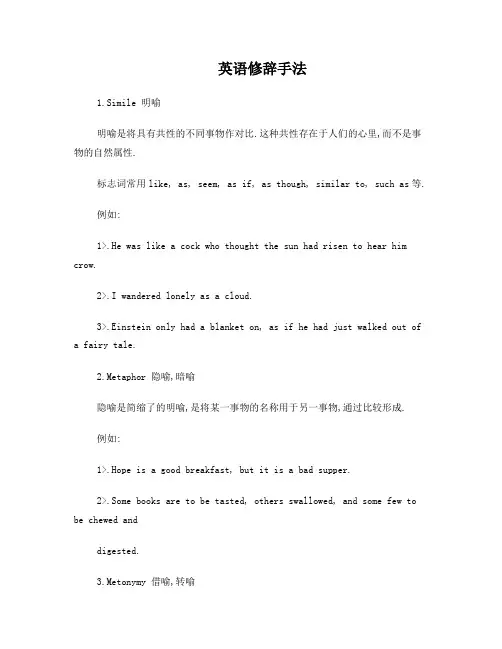
英语修辞手法1.Simile 明喻明喻是将具有共性的不同事物作对比.这种共性存在于人们的心里,而不是事物的自然属性.标志词常用like, as, seem, as if, as though, similar to, such as等.例如:1>.He was like a cock who thought the sun had risen to hear him crow.2>.I wandered lonely as a cloud.3>.Einstein only had a blanket on, as if he had just walked out ofa fairy tale.2.Metaphor 隐喻,暗喻隐喻是简缩了的明喻,是将某一事物的名称用于另一事物,通过比较形成.例如:1>.Hope is a good breakfast, but it is a bad supper.2>.Some books are to be tasted, others swallowed, and some few tobe chewed anddigested.3.Metonymy 借喻,转喻借喻不直接说出所要说的事物,而使用另一个与之相关的事物名称.I.以容器代替内容,例如:1>.The kettle boils. 水开了.2>.The room sat silent. 全屋人安静地坐着.II.以资料.工具代替事物的名称,例如:Lend me your ears, please. 请听我说.III.以作者代替作品,例如:a complete Shakespeare 莎士比亚全集VI.以具体事物代替抽象概念,例如:I had the muscle, and they made money out of it. 我有力气,他们就用我的力气赚钱.4.Synecdoche 提喻提喻用部分代替全体,或用全体代替部分,或特殊代替一般.例如:1>.There are about 100 hands working in his factory.(部分代整体)他的厂里约有100名工人.2>.He is the Newton of this century.(特殊代一般)他是本世纪的牛顿.3>.The fox goes very well with your cap.(整体代部分)这狐皮围脖与你的帽子很相配.5.Synaesthesia 通感,联觉,移觉这种修辞法是以视.听.触.嗅.味等感觉直接描写事物.通感就是把不同感官的感觉沟通起来,借联想引起感觉转移,“以感觉写感觉”。
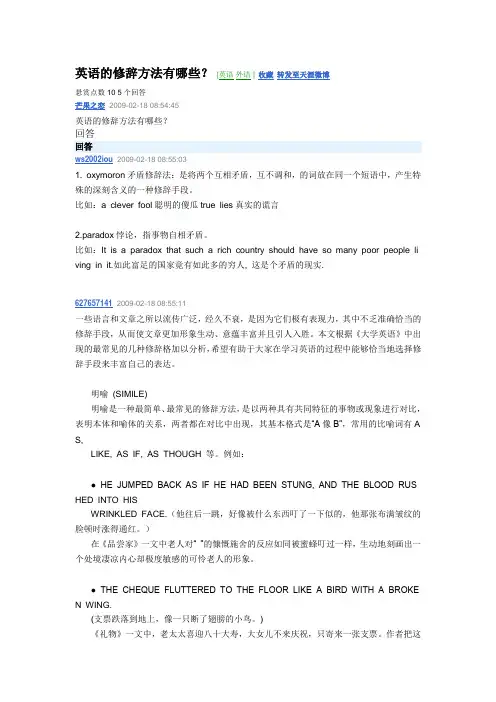
英语的修辞方法有哪些?[英语外语]收藏转发至天涯微博悬赏点数 10 5个回答芒果之恋2009-02-18 08:54:45英语的修辞方法有哪些?回答回答ws2002iou2009-02-18 08:55:031. oxymoron矛盾修辞法:是将两个互相矛盾,互不调和,的词放在同一个短语中,产生特殊的深刻含义的一种修辞手段。
比如:a clever fool聪明的傻瓜true lies真实的谎言2.paradox悖论,指事物自相矛盾。
比如:It is a paradox that such a rich country should have so many poor people li ving in it.如此富足的国家竟有如此多的穷人, 这是个矛盾的现实.6276571412009-02-18 08:55:11一些语言和文章之所以流传广泛,经久不衰,是因为它们极有表现力,其中不乏准确恰当的修辞手段,从而使文章更加形象生动、意蕴丰富并且引人入胜。
本文根据《大学英语》中出现的最常见的几种修辞格加以分析,希望有助于大家在学习英语的过程中能够恰当地选择修辞手段来丰富自己的表达。
明喻(SIMILE)明喻是一种最简单、最常见的修辞方法,是以两种具有共同特征的事物或现象进行对比,表明本体和喻体的关系,两者都在对比中出现,其基本格式是“A像B”,常用的比喻词有A S,LIKE, AS IF, AS THOUGH 等。
例如:● HE JUMPED BACK AS IF HE HAD BEEN STUNG, AND THE BLOOD RUS HED INTO HISWRINKLED FACE.(他往后一跳,好像被什么东西叮了一下似的,他那张布满皱纹的脸顿时涨得通红。
)在《品尝家》一文中老人对“ ”的慷慨施舍的反应如同被蜜蜂叮过一样,生动地刻画出一个处境凄凉内心却极度敏感的可怜老人的形象。
● THE CHEQUE FLUTTERED TO THE FLOOR LIKE A BIRD WITH A BROKE N WING.(支票跌落到地上,像一只断了翅膀的小鸟。
Oxymoron和Paradox这两种修辞的区别“But in the thunderous silence that encapsulated them, she suspected it would bother O’Donnell, even if she wore earphones.”这句话里面用了矛盾修辞法(Oxymoron)。
大家可以试着翻译一下这句话,就会发现这种句子翻译起来很有意思,也有一定的难度,关键在于把看似矛盾的点合理化,让矛盾真正发挥出作用。
来看一下什么是矛盾修辞(Oxymoron):An oxymoron is a figure of speech that combines contradictory words with opposing meanings, like “old news,” “deafening silence,” or “organized chaos.” Oxymorons may seem illogical at first, but in context they usually make sense.矛盾修辞法的例子有很多:accurate estimate, alone together, awfully good, bittersweet, climb down, close distance, grow smaller, only option, originally copy, passive-aggressive, same difference, seriously funny, small crowd, virtual reality.......Oxymoron 和Paradox (隽语,悖论)这两种修辞不太一样。
An oxymoron is a self-contradicting word or group of words (as in Shakespeare’s line from Romeo and Juliet, "Why, then, O brawling love! O loving hate!"/ Parting is such sweet sorrow. ).A paradox is a statement or argument that seems to be contradictory or to go against common sense, but that is yet perhaps still true—for example, "less is more."举几个paradox的例子:“You have to spend money to make money.”“Slow and steady wins the race.”“I can resist anything but temptation.”概括一下,矛盾修辞法和隽语之间的主要区别就是:The main difference between and oxymoron and a paradox is that oxymorons use contradictory words whereas paradoxes use contradictory ideas. An oxymoron is usually just two words (sometimes one, as in “bittersweet”), but a paradox is an entire statement, usually a standalone sentence or even a full paragraph.。
oxymoron矛盾修饰法例句1. 什么是oxymoron矛盾修饰法?矛盾修饰法(oxymoron)是修辞手法的一种,它通常指的是通过将两个自相矛盾的词语或短语放在一起,来创造出一种意义上的矛盾或对比效果。
这种修辞手法在文学作品和口语中都有广泛应用,能够给人留下深刻的印象,突显出作者的文学造诣和思维深度。
2. 典型例句2.1 “冰火两重天”——这个经典的oxymoron例句常常被用来形容截然不同的两种情况或状态。
冰与火是两种完全相反的元素,但在“冰火两重天”中却巧妙地融合在一起,形成了强烈的对比效果。
2.2 “孤独的拥挤”——这个例句中,“孤独”和“拥挤”是两种截然不同的状态,但将它们放在一起却能够产生独特的内涵。
这种用词的巧妙之处在于,它能够让读者感受到一种矛盾而又微妙的情感。
3. 在文学作品中的应用在文学作品中,oxymoron矛盾修饰法常常被用来表达复杂的情感和思想,增强作品的艺术感染力。
在莎士比亚的诗歌与戏剧中,我们经常能够看到像“甜蜜的痛苦”、“明亮的黑暗”等oxymoron例句的出现。
这些例句不仅在语言层面上呈现了一种独特的魅力,更能够深刻地触动读者的内心,使作品的意义更加丰富和多维。
4. 在口语中的应用除了在文学作品中的应用之外,oxymoron矛盾修饰法在口语中也有着广泛的运用。
人们常常会在日常交流和表达中使用这种修辞手法,以增强语言的表达力和生动性。
我们经常会听到类似“无声的喧嚣”、“无味的美食”、“甜蜜的痛苦”等oxymoron例句的使用。
这些例句能够使语言更具传神,同时也能够引起听者对语言背后意义的深入思考。
5. 总结oxymoron矛盾修饰法作为一种修辞手法,能够在文学作品和口语表达中发挥重要的作用。
它通过将两种截然相反的词语或短语放在一起,创造出一种独特的意义和效果,从而增强了语言的表达力和感染力。
无论是在文学创作中,还是在日常交流中,我们都可以发现oxymoron矛盾修饰法的踪迹,它已经成为了丰富语言表达的重要组成部分。
Oxymoron的构成方式和修辞作用
薛玉凤
【期刊名称】《上海翻译》
【年(卷),期】1994(0)3
【摘要】Oxymoron的构成方式和修辞作用薛玉凤oxymoron(矛盾修饰法)是英语修辞格之一,它把两个意义相反、互相矛盾或者互不调和的词有意识地连接在一起,来表达一种表面矛盾实际统一的意思,从而产生一种特殊的语言效果。
试看下面一个例句:Ithasthep...
【总页数】3页(P42-44)
【关键词】构成方式;Oxymoron;矛盾修饰法;修辞作用;形容词性;英语修辞格;修辞功效;朱生豪;心理状态;《罗密欧与朱丽叶》
【作者】薛玉凤
【作者单位】
【正文语种】中文
【中图分类】H314.2
【相关文献】
1.浅析(矛盾修辞法)Oxymoron及其翻译问题 [J], 高尚
2.英语"oxymoron"修辞格汉译之探讨 [J], 冯丽
3.结构分析方法对修辞现象的描写作用和解释力——李胜梅《修辞结构成分与语篇结构类型》读后 [J], 应学凤
4.矛盾修辞法(oxymoron)的汉译 [J], 车俊思
5.Paradox(似非而是的隽语)与Oxymoron(矛盾修辞)的比较与翻译 [J], 李伟芳因版权原因,仅展示原文概要,查看原文内容请购买。